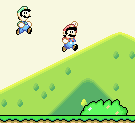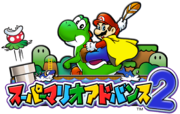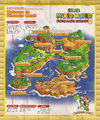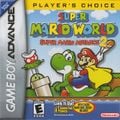Super Mario World: Super Mario Advance 2
Template:Infobox Super Mario World: Super Mario Advance 2 (known in Japan as simply Super Mario Advance 2, スーパーマリオアドバンス2 Sūpā Mario Adobansu Tsū) is a remake of Super Mario World made for the Game Boy Advance and developed by Nintendo Entertainment Analysis and Development (EAD). It is the second title in the Super Mario Advance series and was released in Japan on December 14, 2001, in North America on February 11, 2002, and in Europe and Australia in April 2002. There are numerous gameplay, visual, and level design changes from the original game, but the most noticeable alteration is making the game for one player only instead of two. However, Luigi was still usable, but this time as an alternate character who jumps higher than Mario, but runs slightly slower.
The game was successful, selling over 5,460,000 copies worldwide, with at least 3,290,000 copies in the United States.[citation needed] The Mario Bros. classic game has been included in the game (like the other Super Mario Advance games), with multiplayer. Super Mario World: Super Mario Advance 2 was re-released on the Wii U's Virtual Console in Japan on April 3, 2014, and in North America on December 25, 2014, and in Europe and Australia in March 2016.
Gameplay and premise
- Main article: Super Mario World
The gameplay and plot are the same as in the original version of Super Mario World for the Super Nintendo Entertainment System. Players take control of either Mario or Luigi, adventuring through Dinosaur Land to foil the evil King Bowser and his Koopalings, who have kidnapped Princess Peach (formerly known to the Western world as Princess Toadstool) and imprisoned seven of the native Yoshis in eggs. Players navigate through the game's worlds via an overworld map featuring paths connecting to action panels, Fortresses, etc. The playfields of the levels are populated with obstacles and enemies, with the player traversing the stage by making use of basic techniques from the NES Mario titles, like running, jumping, swimming, dodging, and defeating enemies; and those new to the original Super Mario World, like the Spin Jump.
The same power-ups from the original release are retained, including the basic power-ups of the Super Mushroom, Fire Flower, and Starman; and the Cape Feather, introduced in the original game. The Super Mushroom increases Mario or Luigi's size; the Fire Flower gives him a fireball attack; the Starman makes him invincible; and the Cape Feather allows him to fly and to attack enemies by spinning. Also returning is Yoshi, the Mario brothers' sidekick and riding mount from the original Super Mario World, who is able to eat most enemies and gain special abilities from holding colored Koopa shells in his mouth. The game also contains blue, yellow, and red Yoshis, which become available to Mario and Luigi from any level in the game after he has found their eggs in Star World and fed them enough enemies to grow them to maturity. When holding any Koopa shell in his mouth, these Yoshis gain the ability that corresponds to its own color, in addition to that of the shell.
Outside of the main mode of play, players may also play a remake of the Mario Bros. game, included in all other games in the Super Mario Advance series, which supports anywhere from one to four players.
Changes from the original game
Super Mario Advance 2 has considerably less significant differences from the game it ports than the first Super Mario Advance. Nevertheless, the game contains many gameplay, visual, and other changes from the original Super Mario World, which are explained as follows.
Gameplay
The most noticeable gameplay alteration is the removal of the original two-player feature, making the game for only one player. Because of this, Luigi is reworked as an optional character, who can be swapped out with Mario by pressing ![]() on the world maps. As in the special compilation cartridge Super Mario All-Stars + Super Mario World, Luigi has his own sprite set independent of Mario's; however, this one is based on the appearance of his sprites in the first Super Mario Advance. In addition, he plays differently from Mario in several ways. Luigi jumps higher but more slowly than Mario, and scuttles in midair as he jumps, but he suffers from worse traction and lower running speed than his brother. When Luigi flies using the Cape, he flies slightly higher than Mario, but not as fast; and Fire Luigi's fireballs bounce higher than Fire Mario's. When Luigi is riding him, Yoshi does not instantly swallow enemies; instead, he can spit them out and use them to attack other enemies, automatically swallowing them after a brief amount of time. Finally, if Luigi hits a Coin Block, all of the coins inside it will spill out of the block at once instead of collecting them one by one.
on the world maps. As in the special compilation cartridge Super Mario All-Stars + Super Mario World, Luigi has his own sprite set independent of Mario's; however, this one is based on the appearance of his sprites in the first Super Mario Advance. In addition, he plays differently from Mario in several ways. Luigi jumps higher but more slowly than Mario, and scuttles in midair as he jumps, but he suffers from worse traction and lower running speed than his brother. When Luigi flies using the Cape, he flies slightly higher than Mario, but not as fast; and Fire Luigi's fireballs bounce higher than Fire Mario's. When Luigi is riding him, Yoshi does not instantly swallow enemies; instead, he can spit them out and use them to attack other enemies, automatically swallowing them after a brief amount of time. Finally, if Luigi hits a Coin Block, all of the coins inside it will spill out of the block at once instead of collecting them one by one.
The Fall event, previously made available after the player cleared the Special World, is now locked until the player has cleared all 96 exits, and not only Koopa Troopas, Bullet Bills, and Piranha Plants, but also Galoombas and Pokeys have their appearances changed. Dragon Coins are added to levels that did not originally have them (such as Ghost Houses and Fortresses), and if the player manages to collect all 480 coins in a single file, they have their appearance changed to bear the image of Princess Peach. A status menu is added, accessible by pressing on the world maps, which allows players to check their total play time, score, how many levels they have played (and which brother they used in which levels), and whether or not they have collected all the Dragon Coins in a given level; once all levels have been cleared, the player can press
![]() to automatically access the levels that they select. After the colored Yoshis are unlocked in Star World, ? Blocks yield blue Yoshis if Mario or Luigi is in caped form, red Yoshis if he is in fire form, or yellow Yoshis if he is in small or super form; by this point, the original green Yoshi becomes unavailable. The save system is updated to allow players to save at any time, whether on the playfield or in the world maps, and to even save the player's life count and power-ups. The maximum life count is raised to 999, and the maximum number of extra lives the player can get from jumping on or hitting enemies is raised from three to five; additionally, by earning at least 10 consecutive lives, a flower and text stating how many lives the player earned scrolls across the screen. Mario or Luigi can Spin Jump on certain enemies that they could not in the original version, such as Boos and Lava Bubbles, and Yoshi can now also jump off of fish enemies.
to automatically access the levels that they select. After the colored Yoshis are unlocked in Star World, ? Blocks yield blue Yoshis if Mario or Luigi is in caped form, red Yoshis if he is in fire form, or yellow Yoshis if he is in small or super form; by this point, the original green Yoshi becomes unavailable. The save system is updated to allow players to save at any time, whether on the playfield or in the world maps, and to even save the player's life count and power-ups. The maximum life count is raised to 999, and the maximum number of extra lives the player can get from jumping on or hitting enemies is raised from three to five; additionally, by earning at least 10 consecutive lives, a flower and text stating how many lives the player earned scrolls across the screen. Mario or Luigi can Spin Jump on certain enemies that they could not in the original version, such as Boos and Lava Bubbles, and Yoshi can now also jump off of fish enemies.
Other gameplay changes in this edition include players reverting only to super form and keeping their reserve items upon being hit when in caped or fire form; the eggs that Yoshi produces upon eating ten consecutive berries containing different items for different colors of Yoshis; raising the point values for climbing Koopas and the enemy Chargin' Chuck; removing the special button combination for reentering completed castle and fortresses, so that these areas are not accessible until after the final battle has been won; raising the time limit for Bowser's Castle from 400 to 800 (or 600 if the castle is entered through the back door); displaying the timer in the Top Secret Area and during the fight with Bowser; featuring the full HUD during the final boss battle instead of just the reserve item; and saving the player's best scores for the levels in the Special World after that is cleared.
Other
The design of certain levels is altered; in the case of those levels that did not have Dragon Coins in the original game, their alterations are to accommodate the coins that were added to them. There are more Message Blocks throughout the levels than in the original game; Yoshi's house has ten berries instead of seven; the Super Mushroom lying around in the last room of Lemmy Koopa's castle is changed to a Cape Feather; and in the seventh room of Bowser's Castle (featuring Bowser statues that spit out flames), the first statue does not spit out flames.
The GBA being technically inferior to the SNES, the developers reduced the display resolution to fit better on the GBA (resulting in a "screen crunch"), and brightened the original color palettes to accommodate the absence of a backlight in the handheld's original model. The Mario brothers' overalls were changed to the standard blue, Peach's sprites were redesigned to more accurately resemble her official appearance (i.e., incorporating her established lighter dress color, hair thickness, and blue earring coloration), Bowser and Yoshi's arm colorations were corrected to being their main skin colors, and the Pidgit Bill is redesigned to look like the original Pidgits from Super Mario Bros. 2. The brown boss door in the Chocolate Fortress stage, which was the only door of its color in the SNES version, is recolored red like every other boss door; while the eggs of the seven captured Yoshis are recolored to match the color schemes of the Yoshis trapped in them. Also, the Koopalings and Bowser gain an additional finger on their hands, Larry Koopa's hair is changed to the correct style, and the Bony Beetle is given its own crumble animation instead of sharing one with the Dry Bones.
A pre-title introductory cinema scene is added, where Mario, Luigi, and the princess arrive in Dinosaur Land by hot-air balloon, the brothers fly around Yoshi's Island with capes, and upon their return to the landing spot they find the princess missing and become puzzled; if the player has won the final battle, the ending of the cutscene instead shows the princess being escorted by a Yoshi while Mario and Luigi fly behind. Two other cinematics are added, for when the player has collected all the Dragon Coins and when all the levels have been cleared. Luigi is added to the intro scene where it is stated that the player is in Dinosaur Land and Bowser has kidnapped the princess, he is shown pacing back and forth while Mario is looking up at the text. Magikoopa is added to the "cast list" of enemies after the credits. For the Message Blocks, the heading "Point of Advice" in some of their messages is changed to "Tourist Tips," and after the player has cleared all 96 goals in the game, most blocks' messages are changed to congratulate the player on finding the secret world and clearing all the levels.
In the cutscenes that play after clearing a castle stage, the text is changed to say that both Mario and Luigi have defeated the Koopaling; to describe Iggy as "crazed" rather than the inappropriate "demented"; and to improve the grammar and general flow of the text, e.g. by saying that Wendy O. Koopa has "sung her swan song" rather than her "last song", and calling Chocolate Island "deliciously dangerous" instead of "dangerous (but tasty)". After defeating Bowser, the text after the Koopaling's defeat is shortened, only saying that Mario and Luigi have defeated the Koopaling.
The ending is also altered significantly. Both mentions of Mario are accompanied by mentions of Luigi. Whenever the player replays the level after the first time Bowser is defeated, the text simply states: "Mario and Luigi's adventure is over." Luigi is added in the credits sequence and the return to Yoshi's house; the lesser Mario brother is placed at the end of the line behind the eggs of the trapped Yoshis, but if he was the one who beat Bowser, he swaps places with Mario and vice-versa. The "THE END" screen that appears after the enemy parade is completely overhauled―Mario, Peach, and Luigi are represented with a custom-drawn illustration; the text is restyled to be red with a navy-blue outline; and the background, though initially white, changes to a grass hill when a camera is heard. Additionally, when this screen is displayed, the player is no longer required to reset the system; they may return to the title screen upon pressing .
Interestingly, all mentions of Princess Toadstool are left unchanged in the GBA version, while the text shown after defeating Bowser is changed to mention Peach as opposed to "the princess."
The quality of the entire soundtrack is downgraded for the GBA's inferior sound chip. Digital voice acting is contributed for Mario and Luigi by their famed voice actor Charles Martinet, with a combination of new voice clips and those ripped from the first Super Mario Advance game. Furthermore, the Boos have been given laughter effects, and the Koopalings will shriek upon being dumped into lava pools. New sound effects have also been added for certain actions and events: sliding/skidding, opening the net gates, scanning the map, and the transition of items in the Roulette Block. The pitch of the death jingle is increased by 5 semitones. While in balloon form, the tempo of the music is decreased, and a warning sound is added for when the balloon effect is about to expire.
Development and staff
As shown in published screenshots, an early build retained the original game's HUD, which was altered in the final to fit in better with the GBA's screen resolution.[1] Even the original test levels were left in the game; they can be accessed via a glitch (see below).
The game was produced by Mario creator Shigeru Miyamoto, and directed by Hiroyuki Kimura with supervision from original SNES directors Takashi Tezuka and Toshihiko Nakago. The new graphics were designed by Emi Tomita, and the new audio cues were composed by Yasushi Ida and Taiju Suzuki.
Glitches
These glitches only occur in Super Mario World: Super Mario Advance 2. For a list of glitches that are exclusive to the original Super Mario World or occur in both versions of the game, see here.
- After having found all 96 exits, the player can simultaneously press a
 button and
button and to trigger the status screen, then choose a level and move in an incorrect way going to an incorrect level. Pressing
 will result in no response, an endless Bonus Game, an actual level, or an inaccessible level like the intro level. Some levels (i.e. #2 Morton's Plains) if beaten will glitch the game drastically if the normal exit is taken or revert to the original overworld if the secret exit is taken. For some reason, getting more than 96 exits through this glitch reverts the overworld back to the normal overworld and saving is fatal. Through this glitch, it is possible for the player to access a test level and unused intro from the original game by going to Star World 3, pressing right on the
will result in no response, an endless Bonus Game, an actual level, or an inaccessible level like the intro level. Some levels (i.e. #2 Morton's Plains) if beaten will glitch the game drastically if the normal exit is taken or revert to the original overworld if the secret exit is taken. For some reason, getting more than 96 exits through this glitch reverts the overworld back to the normal overworld and saving is fatal. Through this glitch, it is possible for the player to access a test level and unused intro from the original game by going to Star World 3, pressing right on the  and
and simultaneously, and selecting the second Star Road on the list at the level screen.
- If Mario/Luigi is riding Yoshi with 999 lives, the player may enter a level with possibly at least a 1-Up Mushroom (i.e. Yoshi's Island 2) that was already beaten, stick Yoshi's tongue to the 1-Up Mushroom, and rapidly press
when Yoshi's mouth is full. Upon returning to the map screen from the pause menu, the player's life counter shows up as Y00 (1000). This glitch is temporary and the life counter resets if the player enters another level.
- After completing the game, Mario and Luigi should return to the flattened Yellow Switch Palace, then the player must very quickly press
and down on
 , then select Chocolate Island 3. From there, Mario or Luigi will begin a winding trek back to the flattened Yellow Switch Palace, however it will display Chocolate Island 3's name instead of "Yellow Switch Palace". Upon pressing
, then select Chocolate Island 3. From there, Mario or Luigi will begin a winding trek back to the flattened Yellow Switch Palace, however it will display Chocolate Island 3's name instead of "Yellow Switch Palace". Upon pressing  , Mario or Luigi will be able to re-enter to the Yellow Switch Palace. It should be noted that after returning here, the Yellow ! Switch will not be found at the end as it has already been pressed. Therefore, Mario or Luigi must manually exit the level since there is no other way out.
, Mario or Luigi will be able to re-enter to the Yellow Switch Palace. It should be noted that after returning here, the Yellow ! Switch will not be found at the end as it has already been pressed. Therefore, Mario or Luigi must manually exit the level since there is no other way out. - In the level Outrageous, if Mario or Luigi is riding a Yoshi and falls into the bottomless pit before the last Bullet Bill stand, he can jump off of the Yoshi at the very last second and then be damaged by a Bullet Bill. This must be done in a frame-perfect manner. After beating the level, Mario or Luigi will be riding a Silver Yoshi that acts as a Yellow Yoshi. After Silver Yoshi eats all of the red berries in a level, an egg will hatch not to reveal a Super Mushroom, Fire Flower, Cape Feather, or Starman, but instead a Beach Koopa.
Gallery
Logos
Miscellaneous
Artwork of Cape Mario mounted on Yoshi
Artwork of Mario
Prima Games official guide












